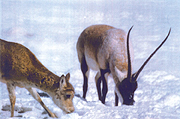|
Dyed in Wool...
|
|
|
|
SHAHTOOSH
The shahtoosh shawl, handcrafted by skilled workers in the Kashmir Valley, has long been acknowledged as a
 piece of fine workmanship, fetching high prices both in India and abroad. piece of fine workmanship, fetching high prices both in India and abroad.
 However, the fact that this activity was illegal and that the shawls were being made from the wool of the endangered Tibetan antelope (Panthalops hodgsonii), commonly known as the Chiru, had not been recognized till the early 1990s. Thus the manufacture of the trade in shahtoosh was illegal. Loopholes in the wildlife protection laws of J&K were also plugged. But there was concern over how the ban on the shahtoosh trade would affect the 30,000-40,000 famlies engaged in, and directly dependant, on the economics of this trade. However, the fact that this activity was illegal and that the shawls were being made from the wool of the endangered Tibetan antelope (Panthalops hodgsonii), commonly known as the Chiru, had not been recognized till the early 1990s. Thus the manufacture of the trade in shahtoosh was illegal. Loopholes in the wildlife protection laws of J&K were also plugged. But there was concern over how the ban on the shahtoosh trade would affect the 30,000-40,000 famlies engaged in, and directly dependant, on the economics of this trade.
|
|

|
|
The premium Pashmina is produced in the Ladakh and J and K region under trying conditions |
|
|
The trade in both raw shahtoosh wool and finished shawls is prohibited or regulated. In 1979, the Chiru was transferred from CITES Appendix II to Appendix I. It meant total prohibition on trade instead of the earlier permission for regulated trade.
There is now a gradual increase as a direct result of conservation practices and protective measures taken by the Chinese Government.
|
|
More... |
|
|
|
|
|
October 2005
|
|

|
|
|
|